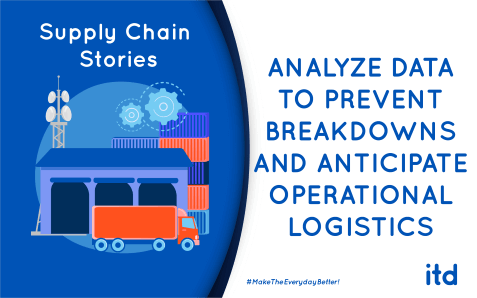
ITD Supply Chain Stories dedicated to analyze data to prevent breakdowns and anticipate operational logistics
How can you achieve this? Florian Gayraud, Projects Director and Supply Chain specialist at ITD, identifies the levers to better prevent breakdowns and anticipate logistics.
There are many data sources and they change over time. Information from the supplier (manufacturer) is probably the first that can be obtained. With a critical and technical eye, they can help identify equipment weaknesses. The warranty, life expectancy data, or even the recommendations in terms of maintenance and care facilitate the implementation of maintenance and swap plans. However, beware of this nominal and sometimes marketed data.
Information from field observations can be collected as soon as the equipment is installed. Collected during an audit or preventive maintenance visit for example. It provides information on the real use, to be compared with the manufacturer’s nominal data or complementary to them on other parameters. Incidents that lead to corrective actions should also be listed and help to bring up decisive information. In general, depending on the objectives set, a multi-source, multi-indicator ecosystem of measurements and evaluation must be defined.
Preventive maintenance aims to act upstream of a problem and not in reaction to its occurrence, which impacts the service. The objective is to identify breakdowns before they occur by repeating a series of checks (measurement, evaluation). It also carries out equipment changes in a preventive and systematic way, according to a predefined time scale.
To be effective, preventive maintenance must respect plans of control and measurement repeated at a defined frequency. These are constituted by considering the data collected and mentioned at the beginning of this article. The idea is to determine precisely what and when; what to check and when to check it. The use of the 5M diagram (also called Fishbone or Ishikawa diagram) can facilitate the identification of risks and potential root causes of an event.
There are various evaluation solutions adapted to the type of equipment, type of materials, and measurement capacity. From the simple reading of a meter or IoT sensors (or other technology) to the realization of non-destructive tests (preferably), it is also possible to use wear parts. The latter allows identifying the state of use of often expensive and/or major equipment. Finally, the objective is to change the equipment at the right time, neither too early – decreasing the ROI – nor too late – generating breakdowns and impacting the service.
Anticipating and planning interventions gives an operational advantage to maintenance managers. They can smooth out and coordinate the activities of their technicians and subcontractors. Interventions can be organized during off-peak periods, limiting the impact in case of deterioration of the current quality of service.
Therefore, it is possible to plan maintenance campaigns by sector or functional area. This directly improves the quality of the verification controls due to two factors:
The geographical concentration also increases the ratio of productive time to travel time. Also, as the interventions are planned during off-peak periods, the loss of income is low. It is even very low compared to an unplanned intervention, which would be a reaction to an identified problem.
The financial consequence is immediate, both in terms of reduced operational costs and maintaining normal revenues when the service is available.
The data collected and associated with the manufacturer’s nominal data helps to predict the occurrence of the next breakdowns. In this way, it is possible to adapt changes or predictive maintenance, planned before the breakdowns. Each new data obtained completes the information base and gives the opportunity to further refine and adapt the execution of maintenance plans.
This is how, depending on the achievement of predetermined indicators (an hourly level, a temperature level, or the number of cycles for example), a specific maintenance action can be triggered and executed. This is done even if there is no failure at the moment.
Data processing awareness can be achieved through a lean management approach. This aims to determine the key data after having clearly defined the objectives, to organize their collection according to the solutions available, and to ensure the analysis of the gaps with the targeted situation. Based on the measurements observed and in iterative phases, it is possible to carry out improvement plans on:
This list is not exhaustive and other complementary approaches can facilitate the achievement of the expected objectives.
The planning of the interventions having each one a defined modus operandi and a listing of pre-determined material (BOQ), which brings visibility in time of the necessary equipment. Target stock levels can be determined for all equipment and adapted according to actual field information. Equipment failure is no longer the norm but becomes the exception. Potentially defective equipment or the cause of the failure has been replaced before the problem occurs. The rate of over-breakdowns (collateral victim) corresponding to equipment deterioration following the failure of another upstream equipment is strongly reduced. The variety of spare parts to be kept in stock is then reduced.
Urgency is no longer the rule, so many ways of improving supply chain performance in its entirety are possible. The predictability of demand allows the organization of a structured and consolidated supply chain at each stage.
The targeted logistical optimization following the implementation of preventive, predictive, or planned maintenance must be justified. The temptation of an overperforming system is high when such global approaches are initiated. Theoretically, it is attractive. But the reality can be much more complex and costly.
So, do the few percent performance gains expected to justify the consequences of over-processing operations? The identification of the added value, a lean management fundamental, is essential to find the right balance between the cost (financial, human, organizational), the inherent risks, and the targeted performance. It is sometimes necessary to accept that the “perfect” can be the enemy of the better.